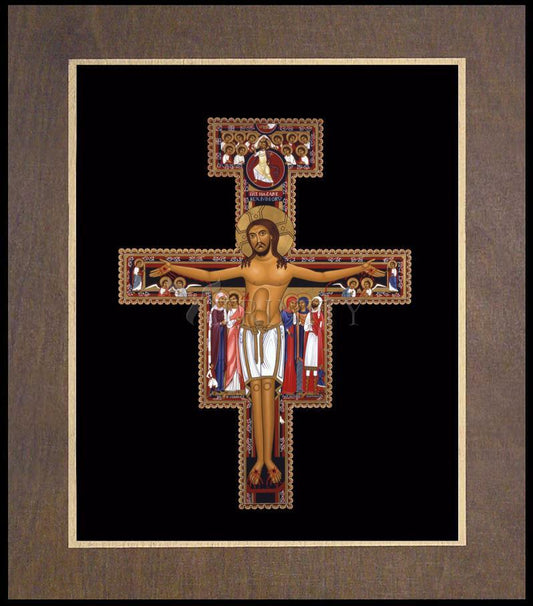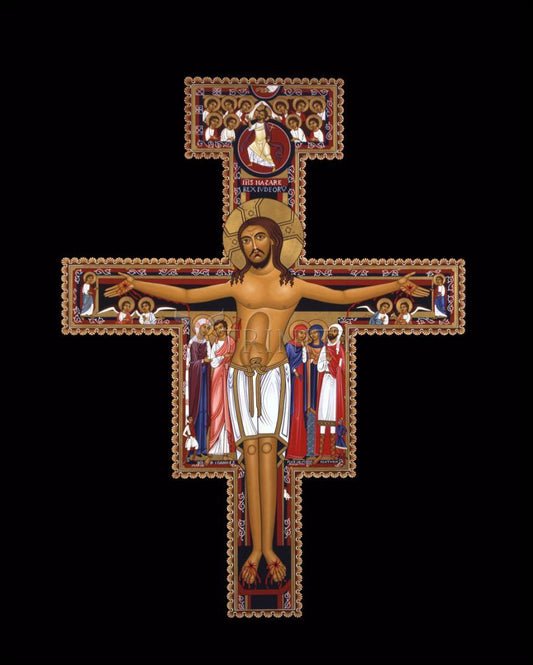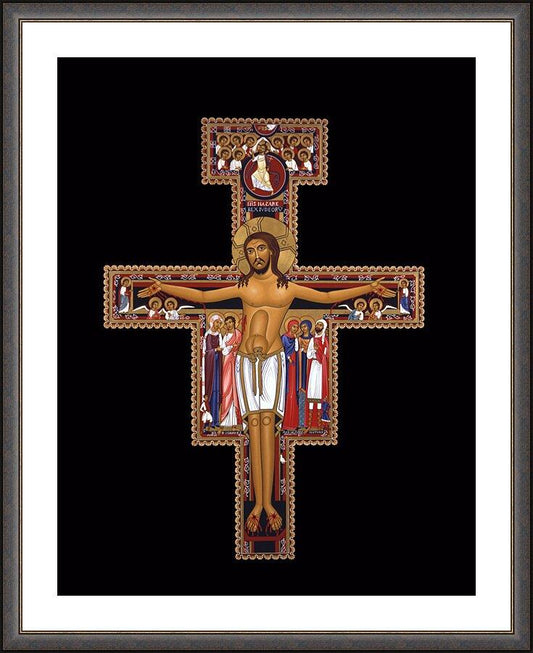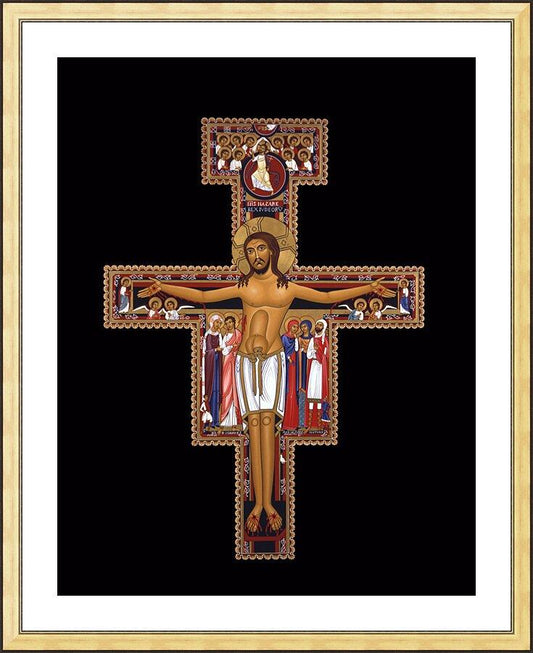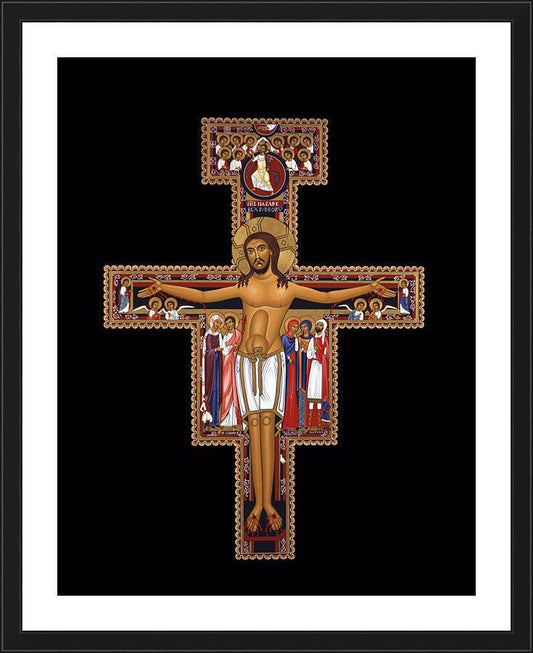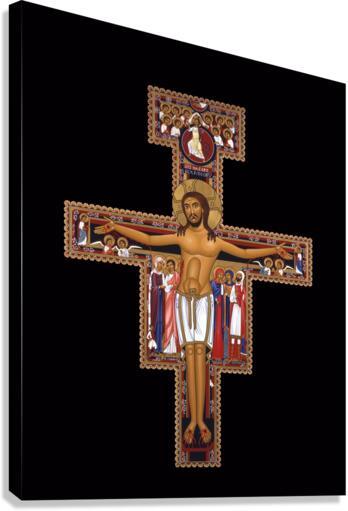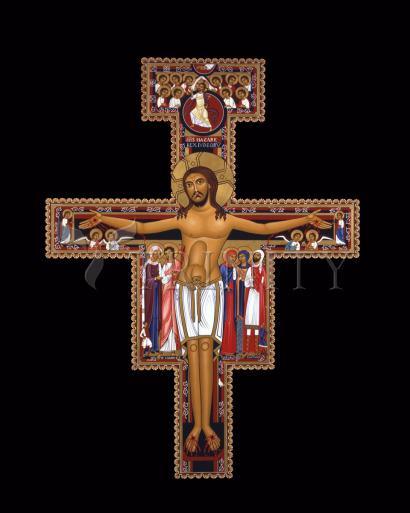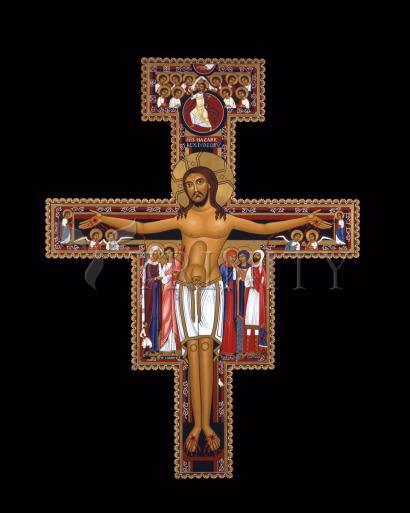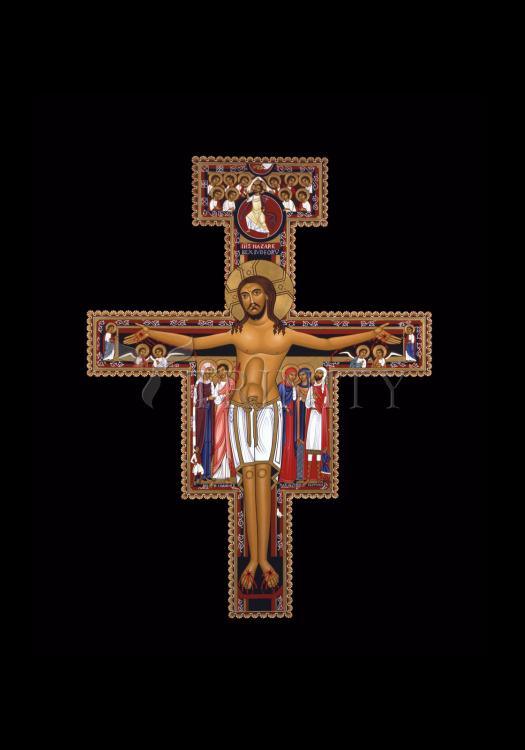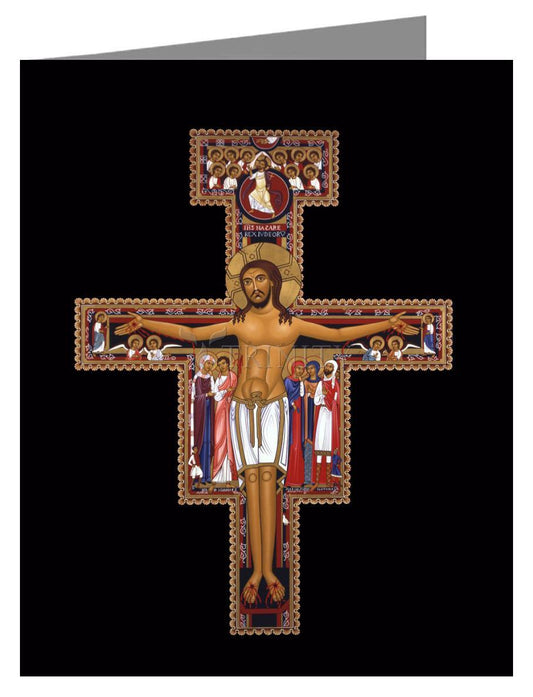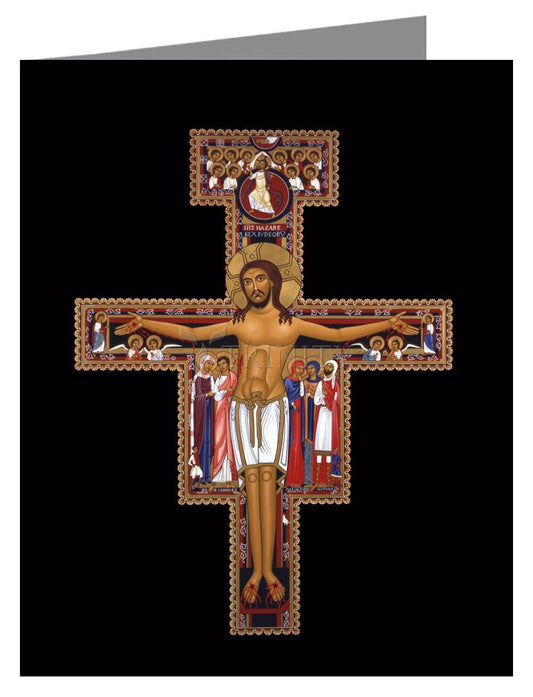The History Of The San Damiano Cross
An unknown Umbrian artist painted the Crucifix Icon in the 12th Century. There is strong Syrian influence, and history tells us that there had been some Syrian monks in the area.
It was painted on wood (walnut) to which cloth had been glued. It is about 190 cm high, 120 cms wide and 12 cms thick. It is more than likely that it was painted for San Damiano to hang over the Altar as the Blessed Sacrament was not reserved in non Parish Churches of those times and especially those that had been abandoned and neglected as we know San Damiano had been.
In 1257 the Poor Clares left San Damiano for San Giorgio and took the Crucifix with them. They carefully kept the Cross for 700 years.
In Holy Week of 1957, it was placed on public view for the first time over the new Altar in San Giorgio's Chapel in the Basilica of St Clare of Assisi.
The Icon of the Transfigured Christ
For Eastern Christians the ICON is a representation of the living God, and by coming into its presence it becomes a personal encounter with the sacred, through the grace of the Holy Spirit. The San Damiano Icon is then a personal encounter with the transfigured Christ -- God made man. The Crucifix contains the story of the death, resurrection and ascension into glory. It expresses the total and universal Paschal Mystery of Christ.
It invites us all to take part in it with a lively and lived faith, just as St Francis did.
Christ's saving death is shown in John's Gospel in its serene majesty, and this Crucifix portrays this in picture form. It is not surprising that Saint Francis was attracted to this Icon and that the inspiration for his life came from this Christ who spoke to him "Go repair my Church..."
THE FIGURE OF THE CHRIST
The central figure of the icon is Christ not only because of the relative size but Christ is a figure of light dominating the scene and giving light to the other figures "I am the light of the world. Whoever follows me will not walk in darkness, but will have the light of life. " (John 8:12). Christ stands upright, not nailed. The eyes of Jesus are open: He looks out to the world, which He has saved. He is alive, the one who is eternal.
Jesus' vestment is a simple loin cloth -- a symbol of both High Priest and Victim. The chest, throat and neck are very strong, Jesus gives power of re-creation to His Disciples (John 22:23). He breathed on His Disciples (John 20:22), the Greek word used recalls the moment of Creation (Gen 2:7). The shadow over the face of Jesus is increased by the fact the halo and face are tilted forward on the original Icon. The humanity of Christ veils the true glory of the Word who lives in the super illuminous darkness of the Godhead.
Behind the outstretched arms of Christ is His empty tomb, shown as a black rectangle.
THE MEDALLION AND INSCRIPTION
The Ascension is portrayed within this circle of red: Christ is breaking out of the circle, holding a golden cross which is now His Royal Scepter. His garments are gold -- a symbol of royalty and victory. His red scarf is a sign of His Dominion and Kingship; exercised in love. Angels welcome Him into Heaven. IHS are the first three letters of the name of Jesus. The little bracket above indicates it is shorthand. NAZARE is the Nazarene; REX is' king' and IUDEORUM is 'of the Jews', which is reported in St John's Gospel " Jesus the Nazarene, King of the Jews."
THE HAND OF THE FATHER
From within the semi-circle at the very top of the Icon, He whom no eye has seen reveals Himself in a benediction. This blessing is given by the right hand of God with the finger extended - the Holy Spirit. The Father gives the gift of the Holy Spirit to all because of the merits of the Christ's Passion.
THE MYSTICAL VINE
Around the Cross are various calligraphic scrolls which may signify the mystical vine "I am the vine, you are the branches... " (John 15), which also contain the words "Greater love has no one than this, that one lays down one 's life for one friends." At the base of the cross there seems to be a section that looks like a rock - the symbol of the Church.
The seashells are symbols of eternity - a mystery hidden in the vast and timeless sea of eternity is revealed.
MARY AND JOHN
As in John's Gospel, Mary and John are placed side by side. Mary's mantle is white meaning victory (Rev 3:5), purification (Rev 7:14); and good deeds (Rev 19:8). The gems on the mantle refer to the graces of the Holy Spirit. The dark red worn under the mantic indicate intense love, while the inner dress is purple -- the Ark of the Covenant (Ex 26: 1-4).
Mary's left hand is raised to her cheek -- her acceptance and love of John, and her right hand points to John while her eyes proclaim acceptance of Christ's words "Woman, behold your son... " (John 19:26). The blood drips on to John at this moment.
John's mantle is rose color indicating eternal wisdom, while his tunic is white -- purity. His position is between Jesus and Mary as is fitting for the disciple loved by both of them. He looks at Mary "Son, behold your Mother", but points to Christ.
NUMBERS
There are 33 figures in the original icon -- Two Christ figures, 1 Hand of the Father, 5 major figures, 2 smaller figures, 14 angels, 2 unknown at His hands, 1 small boy, 6 unknown at the bottom of the Cross and one rooster. There are 33 nail heads along the frame just inside the shells and seven around the halo.
THE OTHER MAJOR FIGURES
Mary Magdalene:
Mary Magdalene is next to Christ making her very special; her hand is on her chin indicating a confided secret "He is risen." She wears scarlet, which is a symbol of love; her mantle of blue deepens this.
Mary Clopas:
Some authorities make her the mother of James. She wears garments of an earthen color a symbol of humility, and her light green mantle -- hope. Her admiration of Jesus is indicated by the gesture of her hand.
The Centurion of Capernaum:
He holds a piece of wood in his left hand, indicating his building of the Synagogue (Luke 7: 1 - 10). The little boy beyond his shoulder is his son healed by Jesus. The three heads behind the boy show "he and his whole household believed" (John 4: 45 - 54). He has extended his thumb and two fingers, a symbol of the Trinity, while his two closed fingers symbolize the hidden mystery of the two natures of Jesus the Christ. "Truly He is the Son of God" (Mark 15:39).
THE LESSER FIGURES
Longinus:
The Roman soldier who pierced Jesus' side with a lance.
Stephen:
Tradition gives this name to the soldier who offered Jesus a sponge soaked in vinegar wine after Jesus cried out "I thirst" (John 19: 28 -30).
THE UNKNOWN SAINTS
At the bottom of the original icon are six unknown saints whom Scholars postulate are Sts Damian, Rufinus, Michael John the Baptist, Peter and Paul, all patrons of Churches in the Assisi area. St Damian was the Patron of the Church that housed the Cross and St Rufinus was the Patron St. of Assisi. There is too much damage of that area to make a proper identification.
THE ASTONISHED ANGELS
There are two groups of angels -- animatedly discussing the scene unfolded before them.
"For God so loved the world that He gave His only begotten Son, that whosoever believes in Him shall not die but have life everlasting" (John 3:16).
THE TOMB
As mentioned before behind Christ is the open tomb; Christ is alive and standing over the tomb. The red of love overcomes the black of death. The gestures of the unknown saints at His hands indicate faith. Could these be Peter and John at the empty tomb? (John 20: 3 - 9).
THE ROOSTER
Firstly, the inclusion of the rooster recalls the denial of Peter who wept bitterly.
Secondly, the rooster proclaims the new dawn of the Risen Christ 1 the true light (1 John 2:8). "But for you who revere my name, the Sun of Righteousness will rise with healing in its wings" (Malachi 4:2 or 3:20 depending on your translation).
THE SHAPE OF THE CROSS
The shape of the Cross has changed to enable the artist to include all who participated in the drama of the Passion. Note that the arms of the cross lift to Christ's right indicating that the Good Thief (traditionally called Dismas) went to Heaven; while the left hand dips -- the other thief did not.
"”Text prepared by Brother Jim Cronly OFM Cap 1995



